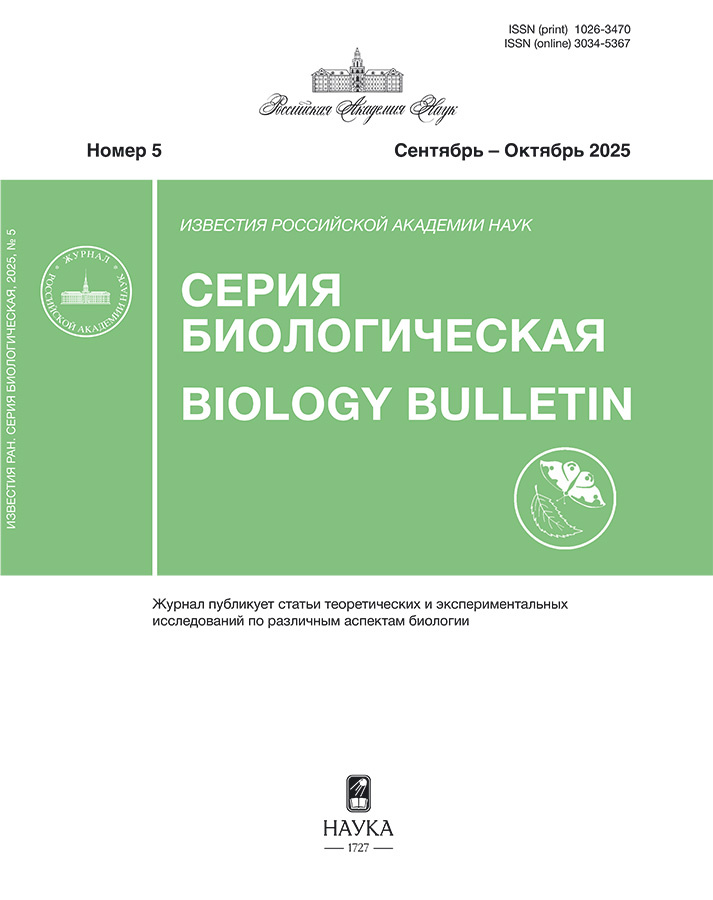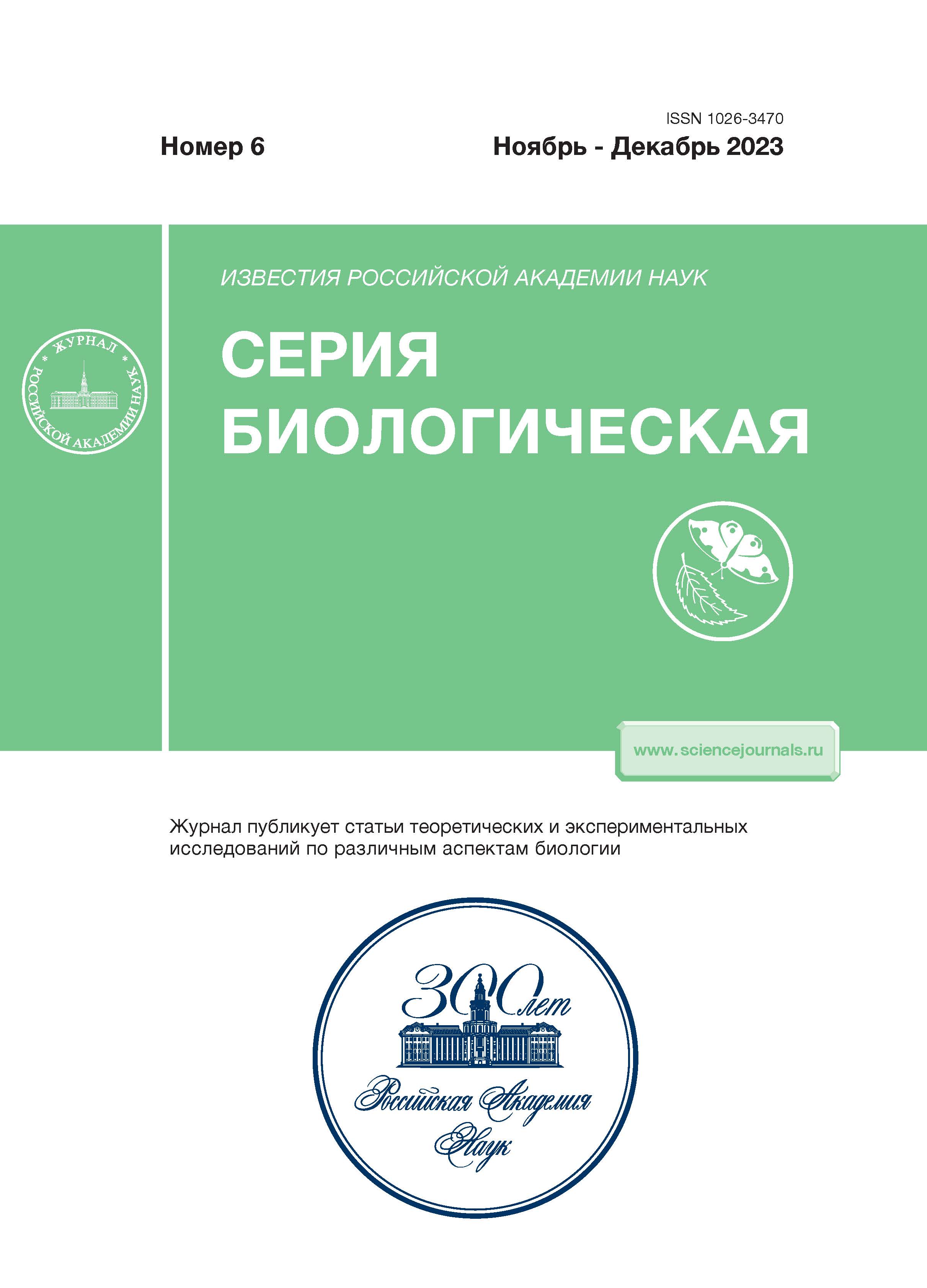Биодеструкция микроцистина-LR автохтонной микробиотой разнотипных водных объектов Северо-Запада России
- Авторы: Медведева Н.Г.1, Зайцева Т.Б.1, Кузикова И.Л.1, Чернова Е.Н.1
-
Учреждения:
- Федеральное государственное бюджетное учреждение науки “Санкт-Петербургский Федеральный исследовательский центр Российской академии наук” (СПб ФИЦ РАН), Санкт-Петербургский научно-исследовательский центр экологической безопасности Российской академии наук
- Выпуск: № 6 (2023)
- Страницы: 687-699
- Раздел: ЭКОЛОГИЯ
- URL: https://cardiosomatics.ru/1026-3470/article/view/647751
- DOI: https://doi.org/10.31857/S1026347022600820
- EDN: https://elibrary.ru/AKYYTC
- ID: 647751
Цитировать
Полный текст
Аннотация
Впервые показана способность автохтонной микробиоты разнотипных водных объектов Северо-Запада РФ деструктировать высокотоксичный микроцистин-LR (MC-LR). Максимальная скорость деградации MC-LR отмечена в водных образцах, отобранных в Сестрорецком разливе и Нижнем Суздальском озере в период массового развития цианобактерий. В образцах воды Ладожского озера, где ранее не были отмечены токсичные цианобактериальные цветения, биодеструкция MC-LR проходила со значительно меньшей скоростью и более длительной лаг-фазой. Состав продуктов биодеградации MC-LR свидетельствует о наличии в составе автохтонной микробиоты исследуемых объектов микроорганизмов, способных деструктировать микроцистины как по mlr механизму, так и по биохимическому пути с участием глутатиона.
Ключевые слова
Об авторах
Н. Г. Медведева
Федеральное государственное бюджетное учреждение науки “Санкт-Петербургский Федеральный исследовательский центр Российской академии наук” (СПб ФИЦ РАН), Санкт-Петербургский научно-исследовательский центр экологической безопасности Российской академии наук
Автор, ответственный за переписку.
Email: ngmedvedeva@gmail.com
Россия, 197110, Санкт-Петербург, ул. Корпусная, д. 18
Т. Б. Зайцева
Федеральное государственное бюджетное учреждение науки “Санкт-Петербургский Федеральный исследовательский центр Российской академии наук” (СПб ФИЦ РАН), Санкт-Петербургский научно-исследовательский центр экологической безопасности Российской академии наук
Email: ngmedvedeva@gmail.com
Россия, 197110, Санкт-Петербург, ул. Корпусная, д. 18
И. Л. Кузикова
Федеральное государственное бюджетное учреждение науки “Санкт-Петербургский Федеральный исследовательский центр Российской академии наук” (СПб ФИЦ РАН), Санкт-Петербургский научно-исследовательский центр экологической безопасности Российской академии наук
Email: ngmedvedeva@gmail.com
Россия, 197110, Санкт-Петербург, ул. Корпусная, д. 18
Е. Н. Чернова
Федеральное государственное бюджетное учреждение науки “Санкт-Петербургский Федеральный исследовательский центр Российской академии наук” (СПб ФИЦ РАН), Санкт-Петербургский научно-исследовательский центр экологической безопасности Российской академии наук
Email: ngmedvedeva@gmail.com
Россия, 197110, Санкт-Петербург, ул. Корпусная, д. 18
Список литературы
- Белякова З.Н., Волошко Л.Н., Гаврилова О.В., Гогорев З.М., Макарова Ю.Б., Рундина Л.А. Водоросли, вызывающие “цветение” водоемов Северо-Запада России. М.: Товарищество научных изданий КМК, 2006. 367 с.
- Воякина Е.Ю., Русских Я.В., Чернова Е.Н., Жаковская З.А. Токсичные цианобактерии и их метаболиты в водоемах Северо-Запада России // Теорeтическая и прикладная экология. 2020. № 1. С. 124–129. https://doi.org/10.25750/1995-4301-2020-1-124-129
- Степанова А.Б., Воякина Е.Ю., Бабин А.В., Зуева Н.В., Зуев Ю.А. Результаты исследований прибрежной зоны Ладожского озера в районе Валаамского архипелага (1998–2019 гг.) в РГГМУ // Гидрометеорология и экология. 2020. № 60. С. 325–350. (Stepanova A.B., Voyakina E.Yu., Babin A.V., Zueva N.V., Zuev Yu.A. Results of studies of the coastal zone of Lake Ladoga in the area of the Valaam archipelago (1998–2019) at RSHU // Gidrometeorologiya i Ekologiya. Hydrometeorology and Ecology (Proceedings of the Russian State Hydrometeorological University). 2020. № 60. P. 325–350) https://doi.org/10.33933/2074-2762-2020-60-325-350
- Чернова Е.Н., Русских Я.В., Подольская Е.П., Жаковская З.А. Определение микроцистинов и анатоксина-а методом жидкостной хромато-масс-спектрометрии низкого разрешения // Научное приборостроение. 2016. Т. 26. № 1. С. 11–25.
- Allocati N., Federici L., Masulli M., Di Ilio C. Glutathione transferases in bacteria // FEBS J. 2009. V. 276. P. 58–75. https://doi.org/10.1111/j.1742-4658.2008.06743.x
- Bourne D.G., Jones G.J., Blakeley R.L., Jones A., Negri A.P., Riddles P. Enzymatic pathway for the bacterial degradation of the cyanobacterial cyclic peptide toxin microcystin LR // Appl. Environ. Microbiol. 1996. V. 62. № 11. P. 4086–4094. https://doi.org/10.1128/AEM.62.11.4086-4094.1996
- Bukowska A., Kaliński T., Chróst R.J. Degradation of microcystins by water and bottom sediment bacterial communities from a eutrophic freshwater lake // Aquat. Microb. Ecol. 2018. V. 82. № 523. P. 129–144. https://doi.org/10.3354/ame01887
- Cao Q., Steinman A.D., Yao L., Xie L. Effects of light, microorganisms, farming chemicals and water content on the degradation of microcystin-LR in agricultural soils // Ecotoxicol Environ Saf. 2018. V. 156. P. 141–147. https://doi.org/10.1016/j.ecoenv.2018.03.030
- Carmichael W.W., Boyer G.L. Health impacts from cyanobacteria harmful algae blooms: Implications for the North American Great Lakes // Harmful Algae. 2016. V. 54. P. 194–212. https://doi.org/10.1016/j.hal.2016.02.002
- Chernova E., Russkikh I., Voyakina E., Zhakovskaya Z. Occurrence of microcystins and anatoxin-a in eutrophic lakes of Saint Petersburg, Northwestern Russia // Oceanol Hydrobiol Stud. 2016. V. 45. № 4. P. 466–476. https://doi.org/10.1515/ohs-2016-0040
- Chorus I., Bartram J. Toxic Cyanobacteria in Water: a Guide to Public Health Significance, Monitoring and Management // World Health Organization. London: Für WHO durch E & FN Spon / Chapman & Hall, 1999. 416 p.
- Chorus I., Falconer I.R., Salas H.J., Bartram J. Health risks caused by freshwater cyanobacteria in recreational waters // J. Toxicol. Environ. Health. Part B. 2000. V. 3. № 4. P. 323–347. https://doi.org/10.1080/109374000436364
- Christoffersen K., Lyck S., Winding A. Microbial activity and bacterial community structure during degradation of microcystins // Aquat. Microb. Ecol. 2002. V. 27. № 2. P. 125–136. https://doi.org/10.3354/ame027125
- Codd G.A., Lindsay J., Young F.M., Morrison L., Metcalf J.S. Harmful cyanobacteria: From mass mortalities to management measures // Harmful cyanobacteria / Eds Huisman J., Matthijs H.C.P., Visser P.M.; Netherlands: Springer, 2005. P. 1–23.
- Cyanobacterial toxins: microcystins. Background document for development of WHO Guidelines for drinking-water quality and Guidelines for safe recreational water environments. Geneva: World Health Organization 2020 (WHO/HEP/ECH/WSH/2020.6). Licence: CC BY-NCSA 3.0 IGO.
- Dziga D., Maksylewicz A., Maroszek M., Budzyńska A., Napiorkowska-Krzebietke A., Toporowska M., Grabowska M., Kozak A., Rosińska J., Meriluoto J. The biodegradation of microcystins in temperate freshwater bodies with previous cyanobacterial history // Ecotoxicol Environ Saf. 2017. V. 145. P. 420–430. https://doi.org/10.1016/j.ecoenv.2017.07.046
- Edwards C., Graham D., Fowler N., Lawton L.A. Biodegradation of microcystins and nodularin in freshwaters // Chemosphere. 2008. V. 73. № 8. P. 1315–1321. https://doi.org/10.1016/j.chemosphere.2008.07
- Esterhuizen-Londt M., Hertel S., Pflugmacher S. Uptake and biotransformation of pure commercial microcystin-LR versus microcystin-LR from a natural cyanobacterial bloom extract in the aquatic fungus Mucor hiemalis // Biotechnology letters / Eds Esterhuizen-Londt M., Hertel S., Pflugmacher S. 2017. V. 39. № 10. P. 1537–1545. https://doi.org/10.1007/s10529-017-2378-2
- Giaramida L., Manage P.M., Edwards C., Singh B.K., Lawton L.A. Bacterial communities’ response to microcystins exposure and nutrient availability: Linking degradation capacity to community structure // Int. Biodeterior. Biodegradation. 2013. V. 84. P. 111–117. https://doi.org/10.1016/j.ibiod.2012.05.036
- Ho L., Dreyfus J., Boyer J., Lowe T., Bustamante H., Duker P., Meli T., Newcombe G. Fate of cyanobacteria and their metabolites during water treatment sludge management processes // Sci. Total Environ. 2012. V. 424. P. 232–238. https://doi.org/10.1016/j.scitotenv.2012.02.025
- Hu C., Zuo Y., Peng L., Gan N., Song L. Widespread Distribution and Adaptive Degradation of Microcystin Degrader (mlr-Genotype) in Lake Taihu, China // Toxins. 2021. V. 13. Article 864. https://doi.org/10.3390/toxins13120864
- Kiviranta J., Sivonen K., Lahti K., Luukkainen R., Niemelä S.I. Production and biodegradation of cyanobacterial toxins – a laboratory study // Arch. Hydrobiol. 1991. V. 121. № 3. P. 281–294. https://doi.org/10.1127/archiv-hydrobiol/121/1991/281
- Krausfeldt L.E., Steffen M.M., Mckay R.M., Bullerjahn G.S., Boyer G.L., Wilhelm S.W. Insight into the molecular mechanisms for microcystin biodegradation in Lake Erie and Lake Taihu // Front. Microbiol. 2019. V. 10. Article 2741. https://doi.org/10.3389/fmicb.2019.02741
- Krishnan A., Zhang Y.-Q., Mou X. Isolation and Characterization of Microcystin-Degrading Bacteria from Lake Erie // Bull Environ Contam and Toxicol. 2018. https://doi.org/10.1007/s00128-018-2468-4
- Kumar P., Hegde K., Brar S.K., Cledon M., Kermanshahi-Pour A. Potential of biological approaches for cyanotoxin removal from drinking water: A review // Ecotoxicol Environ Saf. 2019. V. 172. P. 488–503. https://doi.org/10.1016/j.ecoenv.2019.01.066
- Lezcano M.Á., Quesada A., El-Shehawy R. Seasonal dynamics of microcystin-degrading bacteria and toxic cyanobacterial blooms: Interaction and influence of abiotic factors // Harmful Algae. 2018. V. 71. P. 19–28. https://doi.org/10.1016/j.hal.2017.11.002
- Li J., Li R., Li J. Current research scenario for microcystins biodegradation – A review on fundamental knowledge, application prospects and challenges // Sci Total Environ. 2017. V. 595. P. 615–632. https://doi.org/10.1016/j.scitotenv.2017.03.285
- Li J., Li J., Shi G., Mei Z., Wang R., Li D. Discerning biodegradation and adsorption of microcystin-LR in a shallow semi-enclosed bay and bacterial community shifts in response to associated process // Ecotoxicol Environ Saf. 2016. V. 132. P. 123–131. https://doi.org/10.1016/j.ecoenv.2016.05.033
- Maghsoudi E., Fortin N., Greer C., Maynard C., Pagé A., Duy S.V., Sauvé S., Prévost M., Dorner S. Cyanotoxin degradation activity and mlr gene expression profiles of a Sphingopyxis sp. isolated from Lake Champlain, Canada // Environ Sci Process Impacts. 2016. V. 18. № 11. P. 1417–1426. https://doi.org/10.1039/c6em00001k
- Massey I.Y., Yang F.A. Mini Review on Microcystins and Bacterial Degradation // Toxins. 2020. V. 12. № 4. 268. https://doi.org/10.3390/toxins12040268
- Medvedeva N.G., Kuzikova I.L. Mycrocystin-LR degradation by indigenous bacterial community of Rybinsk reservoir // IOP Conference Series “Earth and Environmental Science”. 2021. V. 834. № 1. Article 012066. https://doi.org/10.1088/1755-1315/834/1/012066
- Medvedeva N., Zaytseva T., Kuzikova I. Cellular responses and bioremoval of nonylphenol by the bloom-forming cyanobacterium Planktothrix agardhii 1113 // J. Mar. Syst. 2017. V. 171. P. 120–128. https://doi.org/10.1016/j.jmarsys.2017.01.009
- Meriluoto J., Spoof L., Codd G.A. Handbook of Cyanobacterial Monitoring and Cyanotoxin Analysis. John Wiley and Sons, Ltd, Chichester, UK. 2017.
- Mou X., Lu X., Jacob J., Sun S., Heath R. Metagenomic identification of bacterioplankton taxa and pathways involved in microcystin degradation in Lake Erie // PloS one. 2013. V. 8. № 4. Article e61890. https://doi.org/10.1371/journal.pone.0061890
- Rapala J., Lahti K., Sivonen K., Niemelä S. Biodegradability and adsorption on lake sediments of cyanobacterial hepatotoxins and anatoxin-a // Lett. Appl Microbiol. 1994. V. 19. P. 423–428. https://doi.org/10.1111/j.1472-765x.1994.tb00972.x
- Rastogi R.P., Sinha R.P., Incharoensakdi A. The cyanotoxin-microcystins: current overview // Rev. Environ. Sci. Biotechnol. 2014. V. 13. P. 215–249. https://doi.org/10.1007/s11157-014-9334-6
- Redouane E.M., El Amrani Zerrifi S., El Khalloufi F., Oufdou K., Oudra B., Lahrouni M., Campos A., Vasconcelos V. Mode of action and fate of microcystins in the complex soil-plant ecosystems // Chemosphere. 2019. V. 225. P. 270–281. https://doi.org/10.1016/j.chemosphere.2019.03
- Salter C., VanMensel D., Reid T., Birbeck J., Westrick J., Mundle S.O.C., Weisener C.G. Investigating the microbial dynamics of microcystin-LR degradation in Lake Erie sand // Chemosphere. 2021. V. 272. Article 129873. https://doi.org/10.1016/j.chemosphere.2021.12
- Schmidt J., Wilhelm S., Boyer G. The Fate of Microcystins in the Environment and Challenges for Monitoring // Toxins. 2014. V. 6. № 12. P. 3354–3387. https://doi.org/10.3390/toxins6123354
- Shimizu K., Maseda H., Okano K., Itayama T., Kawauchi Y., Chen R., Zhang Z., Sugiura N. How microcystin-degrading bacteria express microcystin degradation activity // Lakes & Reservoirs: Research & Management. 2011. V. 16. № 3. P. 169–178. https://doi.org/10.1111/j.1440-1770.2011.00480.x
- Sivarajah B., Simmatis B., Favot E.J., Palmer M.J., Smol J.P. Eutrophication and climatic changes lead to unprecedented cyanobacterial blooms in a Canadian sub-Arctic landscape // Harmful Algae. 2021. V. 105. Article 102036. https://doi.org/10.1016/j.hal.2021.102036
- Sivonen K., Jones G. Chapter 3: Cyanobacterial toxins. In: Chorus I., Bartram J. (Eds.), Toxic Cyanobacterial in Water: A Guide to Their Public Health Consequences, Monitoring and Management. WHO, 1999. P. 55–124.
- Toruńska-Sitarz A., Kotlarska E., Mazur-Marzec H. Biodegradation of nodularin and other nonribosomal peptides by the Baltic bacteria // Int Biodeterior Biodegradation. 2018. V. 134. P. 48–57. https://doi.org/10.1016/j.ibiod.2018.08.004
- Tsuji K., Naito S., Kondo F., Ishikawa N., Watanabe M.F., Suzuki M., Harada K. Stability of microcystins from cyanobacteria: effect of light on decomposition and isomerization // Environ. Sci. Technol. 1994. V. 28. P. 173–177. https://doi.org/10.1021/es00050a024
- Zurawell R.W., Chen H., Burke J.M., Prepas E.E. Hepatotoxic cyanobacteria: a review of the biological importance of microcystins in freshwater environments // J. Toxicol. Environ. Health, Part B: Critical Reviews. 2005. V. 8. P. 1–37. https://doi.org/10.1080/10937400590889412
- Zhu F.-P., Han Z.L., Duan J.L., Shi X.S., Wang T.T., Sheng G.P., Wang S.-G., Yuan X.-Z. A novel pathway for the anaerobic biotransformation of microcystin-LR using enrichment cultures // Environ Polut. 2019. V. 247. P. 1064–1070. https://doi.org/10.1016/j.envpol.2019.02.013
Дополнительные файлы

















